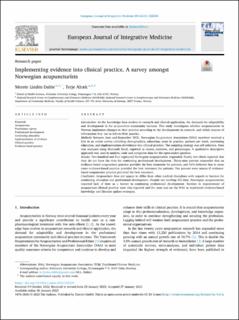| dc.contributor.author | Dahle, Merete Lindén | |
| dc.contributor.author | Alræk, Terje | |
| dc.date.accessioned | 2023-08-09T10:54:13Z | |
| dc.date.available | 2023-08-09T10:54:13Z | |
| dc.date.created | 2023-02-06T09:40:30Z | |
| dc.date.issued | 2023 | |
| dc.identifier.citation | European Journal of Integrative Medicine. 2023, 59. | en_US |
| dc.identifier.issn | 1876-3820 | |
| dc.identifier.uri | https://hdl.handle.net/11250/3083185 | |
| dc.description.abstract | Introduction
As the knowledge base evolves in research and clinical application, the demands for adaptability and development in the acupuncture community increase. This study investigates whether acupuncturists in Norway implement changes in their practice according to the developments in research, and which sources of information they use to inform their practice.
Methods
Between June and September 2021, Norwegian Acupuncture Association (NAA) members received a link to an online survey collecting demographics, education, years in practice, patients per week, continuing education, and implementation of evidence into clinical practice. The sampling strategy was self-selection. Data was analysed using Microsoft Excel, reported as means, numbers, and percentages. A qualitative descriptive approach was used to analyse, code and categorise data for the open-ended question.
Results
Two hundred and four registered Norwegian acupuncturists responded. Nearly two thirds reported that they do not have the time for continuing professional development. Thirty-nine percent responded that an evidence-based acupuncture practice provides the best treatment for patients, and 51% believed that in some cases evidence-based practice provided the best treatment for patients. Ten percent were unsure if evidence-based acupuncture practice provided the best treatment.
Conclusion
Acupuncture does not appear to differ from other medical disciplines with regards to barriers for continuing education and professional development. Despite not working full-time, Norwegian acupuncturists reported lack of time as a barrier to continuing professional development. Barriers to improvement of acupuncture clinical practice were also reported and the onus was on the NAA to implement evidence-based knowledge and likewise update strategies. | en_US |
| dc.language.iso | eng | en_US |
| dc.relation.uri | https://doi.org/10.1016/j.eujim.2023.102234 | |
| dc.rights | Navngivelse 4.0 Internasjonal | * |
| dc.rights.uri | http://creativecommons.org/licenses/by/4.0/deed.no | * |
| dc.subject | acupuncture | en_US |
| dc.subject | professional development | en_US |
| dc.subject | practitioner survey | en_US |
| dc.subject | evidence-based practice | en_US |
| dc.title | Implementing evidence into clinical practice. A survey amongst Norwegian acupuncturists | en_US |
| dc.title.alternative | Implementing evidence into clinical practice. A survey amongst Norwegian acupuncturists | en_US |
| dc.type | Peer reviewed | en_US |
| dc.type | Journal article | en_US |
| dc.description.version | publishedVersion | en_US |
| dc.source.volume | 59 | en_US |
| dc.source.journal | European Journal of Integrative Medicine | en_US |
| dc.identifier.doi | 10.1016/j.eujim.2023.102234 | |
| dc.identifier.cristin | 2123184 | |
| dc.source.articlenumber | 102234 | en_US |
| cristin.ispublished | true | |
| cristin.fulltext | original | |
| cristin.qualitycode | 1 | |

